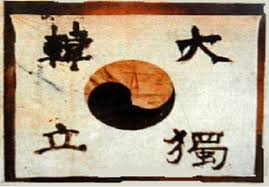
Ahn
The Korean Independence Movement, a noble endeavor to free Korea from Japanese oppression, utilized diplomatic finesse and militant tactics. This historic movement commenced in 1910 and reached its triumphant conclusion in 1945. Japan had learned the advanced cultures of Western nations, swiftly modernized, and set its sights on Korea. Through a series of calculated maneuvers, Japan stripped Joseon of its rights, engaged in conflicts with rival nations vying for control, and gradually subjugated the land. Ultimately, Japan annexed Joseon, marking the beginning of the dark era known as the Japanese colonial period. Korea initiated the Korean Independence Movement on the 1st of March in 1910 to preserve the sovereignty of Korea. It is one of the most tragic chapters in Korea’s past that has left a lasting impact on the nation to date. Despite the numerous individuals who devoted their lives and made ultimate sacrifices to secure Korea’s freedom, the contributions of certain activists, particularly women, have not received the recognition and honor they deserve. One of them is Ahn Seongnyeo, who was born in 1881 in Cheonggye-dong, Sincheon-gun, Hwanghae-do. Ahn Seongnyeo was a courageous female Korean independence activist who played a crucial role in fighting against oppression and advocating for freedom. It is essential to acknowledge that the Korean Independence Movement’s success was significantly facilitated by the impactful contributions made by Ahn Seonghyeo behind the scenes.
Ahn Seongnyeo, born as the daughter of Jinsa Ahn Tae Hun and Jo Maria, alongside her three sons, was part of a remarkable family tree that included her well-known older brother, the Korean independence activist Ahn Jung-Geun, and her younger siblings An Jeong-Geun and Ahn Gong-geun. Despite the limited information available about her early years, Ahn Seongnyeo’s intriguing life story truly unfolds in adulthood. Ahn Seongnyeo married Seungbok Kwon upon reaching adulthood, and together, they welcomed a son named Heon Kwon into the world. Residing in Harbin, China, Ahn Seongnyeo displayed great sewing ability and successfully operated a thriving tailor shop with her husband. Ahn Seongnyeo functioned as a civilian during this time, motivated by her family’s steadfast backing of independence to become a prominent figure in the Korean independence movement.
For instance, Ahn Jung-Geun, the brother of Ahn Seongnyeo, killed Ito Hirobumi in Harbin, China. Ito Hirobumi was a prominent Japanese politician and statesman who notably served as the first Prime Minister of Japan and is remembered for his role in coercing the signing of the Japan-Korea Treaty. Additionally, Ahn Seongnyeo’s mother, Jo Maria, played a significant role in advocating for various movements in Korea. She actively promoted the National Education Movement and The National Debt Redemption Movement while supporting the Independence Movement through multiple means.
Throughout the Korean Independence Movement, Ahn Seongnyeo achieved three significant accomplishments that played an essential role in advancing the cause of independence in Korea. To begin with, it is crucial to note that she showed exceptional dedication by actively participating in the production and repair of uniforms for the independent army. Ahn Seongnyeo set up a sewing unit to produce warm uniforms for the independent soldiers.
As a result of Ahn Seongnyeo’s work, soldiers were equipped to safeguard themselves during brutal weather conditions while presenting themselves in a tidy, well-maintained military uniform, enhancing functionality and professionalism on the battlefield. Moreover, Ahn Seongnyeo let her tailor shop transform into a secret meeting place for activists and soldiers fighting for independence. It quickly became a center for resistance, despite the constant watch of Japanese soldiers and police. Ahn Seongnyeo fearlessly helped with the exchange and transport of important documents, showing unwavering support for the underground movement.
Furthermore, not only did she utilize the funds earned from her sewing endeavors to contribute to the support of the Independence Army’s military finances, but she also played a major role in boosting their operational capabilities through her dedicated efforts.
The independent funds that were backed by Ahn Seongnyeo potentially served as crucial resources by providing weapon supplies, such as guns, to support the soldiers actively involved in the Korean Independence Movement. Lastly, Ahn Seongnyeo’s bold behavior and actions, as the younger sister of Ahn Jung-Geun, faced strict Japanese surveillance during the Korean Independence Movement. In 1910, on the 26th of March, just before Ahn Jung-geun’s execution, Ahn Seongnyeo was arrested by Japanese police on her way back from visiting family. She suffered nine days of torture, and Japanese police were attempting to get information about independence fighters.
Throughout history, a multitude of torture methods have been employed, including confining individuals in wooden tablets positioned over a pail, subjecting them to violent shaking, forcing them to lie naked on the ground, striking them 60 times with a cudgel, and placing them on a small wooden frame that is shorter than their height and narrower than their shoulder width to prevent sleep.
We may not have specific details about the torture inflicted on Ahn Seongnyeo. However, it is reasonable to assume that she endured one of the typical torture techniques commonly used during that period. Ahn Seongnyeo’s existence never experienced improvement but rather continued to deteriorate. Her spouse, Seungbok Kwon, passed away during the 1920s, adding to her hardships.
Even facing a difficult and emotional situation where feelings were intense, and obstacles appeared overwhelming, Ahn Seongnyeo decided to relocate to the North Manchurian region, where the independent army was gathered together and did not stop her advocacy for liberation. Subsequently, she was once again captured by Japanese police and endured 15 days of relentless interrogation. Throughout this time, she remained resolute in her refusal to betray the courageous freedom fighters who had placed their trust in her. Despite the intense pressure, she never wavered in her commitment to protecting their secrets.
On the 15th of August, 1945, Korea finally achieved liberation from Japan, marking a jubilant occasion that filled the streets with exuberant celebrations. Crowds of citizens, joined by passionate activists, joyfully waved the Korean flag high above their heads or proudly carried it as a symbol of their newfound freedom. Despite achieving the goal of liberation, Ahn Seongnyeo encountered a series of new challenges upon her return to Korea with her son.
Ahn Seongnyeo struggled to pioneer her life in a country ravaged by war; she found herself in a state of great need without the support of any relatives or connections. As if that wasn’t enough, the conflict, known as the 6.25 War, commenced on the 25th of June, 1950. This historic battle unfolded between the nations of North and South Korea, with North Korea harboring ambitions of territorial expansion into the South. The war plunged her into chaos, forcing her to flee to the port city of Busan in search of safety from the conflict.
Initially residing in a double-room house in Bong Nae-dong, Yeongdo, given to her by the mayor of Busan, Ahn Seongnyeo, she eventually moved to a hillside in Sinseon-dong, Yeongdo. Despite the kindness shown to her, she decided to relocate once again due to feeling uncomfortable living with strangers in the same house. It was during her time in Busan that she sadly succumbed to a chronic illness on the 8th of April, 1954. She was laid to rest in Yongho-dong, Nam-gu, Busan, where a tombstone was erected in 1973—an enduring tribute to her indomitable spirit. The tombstone was refurbished in 2016 and, most recently, on the 30th of June, 2024, ensuring her memory lives on.
Ahn Seongnyeo and other Korean Independence activists have changed Korea with their unwavering tenacity and bravery. Ahn Seongnyeo’s efforts have made a lasting impact on Korea’s history and today’s lives. Her pivotal role in creating uniforms, providing essential resources for independence initiatives, hosting clandestine meetings, and securely exchanging critical documents was crucial in liberating Korea from Japanese colonial rule.
Reflecting on her life, It is not just essential, but we must honor and preserve the invaluable contributions of Ahn Seongnyeo and all Independence Movement activists as a reminder of their sacrifices and tireless efforts for Korea’s freedom. Whenever you feel discouraged because you’re unsure when your hard work will pay off, remember Ahn Seongnyeo and stay motivated. Keep pushing forward, and never give up. Success will come your way eventually!
By: Stephanie Koo
Write and Win: Participate in Creative writing Contest & International Essay Contest and win fabulous prizes.


